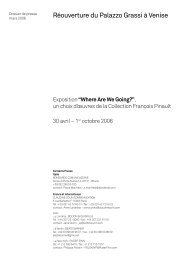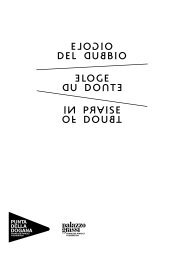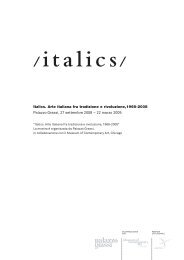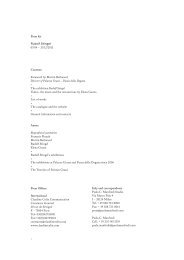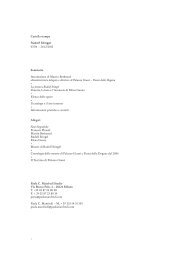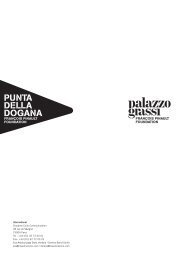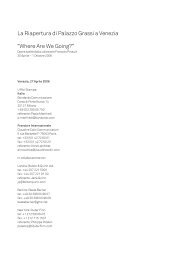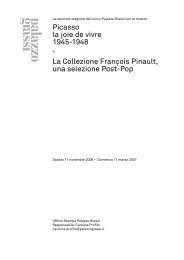pdf file, 1,19 Mb - Palazzo Grassi
pdf file, 1,19 Mb - Palazzo Grassi
pdf file, 1,19 Mb - Palazzo Grassi
You also want an ePaper? Increase the reach of your titles
YUMPU automatically turns print PDFs into web optimized ePapers that Google loves.
the family isolates its children from the world, sentencing them forever to autoreferential artistic<br />
isolation. “Italics” is then perhaps a naive attempt to imagine what could have happened to the Italian<br />
art world if it had comprised a population of autonomous individuals rather than small packs of<br />
conformists. Thus “Italics” proposes to give voice to those who have been rarely been recognized outside<br />
of Italy; to engage Italian and international contemporary culture in a dialogue which, up to now, has<br />
been impossible.<br />
The great art historian Carlo Giulio Argan used to say that the works that make art history are not the<br />
good ones or the bad ones, but the “right” ones. It all depends on what meaning we give to the word right.<br />
For me, a work of art is “right” when it reflects the time and context to which it belongs. I believe Argan<br />
meant something different by the word: what was “right” for him was a work conceived according to<br />
certain aesthetic parameters, following specific directions dictated by a particular ideology (in his case<br />
some form of unorthodox Marxism). We could say he was a “Divo” of the Italian art world—an art world<br />
that was penalized by his rigorous approach to art criticism and history. The moral parameters drawn by<br />
Argan between the “right” and the “wrong” art have created an Italian anomaly that excludes many<br />
artists who, for one reason or another, existed outside any kind of family. Of course, one could say that<br />
Burri, Fontana or Morandi contradict my thesis about the family syndrome. But I think that they are the<br />
exceptions that confirm the rule. They are the three kings that will bring the infant Italian artists of the<br />
seventies and the nineties three gifts: gesture, material, and object. “Italics” is not based on a thesis but<br />
rather on a situation: in Italy the group has had the upper hand over the individual identity of the single<br />
artist. This state of things has been reinforced by the total absence of an effective museum system and<br />
of art schools opened to outside dialogue; and it has been perpetuated by a network of public<br />
universities ruled by a cartel of “power barons” who base their obsolete visions of art history on Argan’s<br />
criterion of “the right.” It is this lucid and opinionated, but utterly ideological, art criticism—paired with<br />
all the defects afflicting the Italian artist from birth—which has produced this unique context within<br />
Western contemporary art. This country blessed with so many exceptional talents has trapped them in<br />
an invisible box: Italian art since <strong>19</strong>68. “Italics” does not pretend to rewrite forty years of art history but<br />
rather to tell a different tale in a new way.<br />
The curator in this case is not an art historian or art critic but an explorer, anthropologist, and<br />
archeologist of the present—an astronomer studying a semi-unknown galaxy. “Italics” is the hypothesis<br />
of a new universe constructed with artworks that aspire not to be “right” in an absolutist way but in<br />
relation both to the context in which they were formed and to the others in the exhibition. Thus the<br />
exhibition has been conceived as a series of encounters between both strangers and old friends, who<br />
bring one another new and different information that is not dictated by a specific chronology. As such,<br />
there will certainly be artists missing that perhaps should have been considered. Yet those missing in<br />
action are not the result of some kind of purge but instead of a deep consideration of the work of each<br />
artist. It is possible that some of the artists missing, who perhaps have been always considered<br />
essential in the official history of Italian art, simply did not provide any relevant work for the period<br />
defined by the exhibition. “Italics” does not venture into hybrid territories that encompass design,<br />
cinema, architecture, fashion, or theater but remains strictly within the purview of visual art. Although<br />
there are figures such as Romeo Castellucci and the Socìetas Raffaello Sanzio, who have transformed<br />
Italian theater into pure contemporary art (just as Carmelo Bene did in the seventies with his stage and<br />
8






